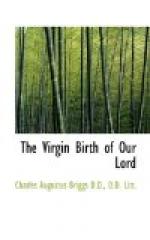It is hard to bring one’s self to speak of the theory put forward by Professor Usener, in which he says that the story of the Virgin-Birth is traceable “to a pagan substratum, and that it must have arisen in Gentile circles."* Surely this is wholly contrary to all probability. How can any serious student think that any but Jewish hands could have penned the first two chapters of St. Matthew’s Gospel? “The story,” says Professor Chase, “moves, like that of St. Luke, within the circle of Eastern conceptions; it is pre-eminently and essentially Jewish. Moreover, if time is to be found for the complicated interaction between paganism and Christianity which this theory involves, the First and Third Gospels must be placed at a date which I believe is quite untenable."+
— * Encyc. Bibl., iii. 3352. + Chase, Supernatural Elements in our Lord’s Earthly Life, p. 21. —
That there are differences and even discrepancies between the two accounts, which are manifestly independent of one another, serves surely to strengthen their witness to the great central fact in which they are at one—that Christ was born of a Virgin-Mother at Bethlehem, in the days of Herod the king.
There appears, then, to be no reason for doubting that in St. Luke’s Gospel we have a genuine account derived from Mary herself, and that in St. Matthew’s Gospel we have an account left by St. Joseph, “worked over by the Evangelist in view of his predominant interest—that of calling attention to the fulfilments of prophecies."* Wherever, therefore, these two Gospels had reached in the second half of the first century, there the story of the Virgin-Birth was known. If the story thus attested by the first and third Evangelists were really a fiction, it is hard indeed to believe that it would not have been contradicted by some who were still living, and who knew that the story was different from that which the Mother herself had delivered them. “If,” says Dean Alford, speaking of the Third Gospel, “not the mother of our Lord herself, yet His brethren were certainly living; and the universal reception of the Gospel in the very earliest ages sufficiently demonstrates that no objection to this part of the sacred narrative had been heard of as raised by them."+




